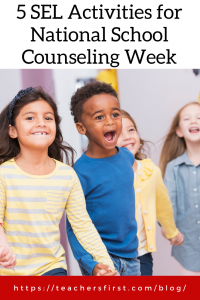School Counselors provide a unique and vital role within their schools. According to the American School Counselor Association (ACSA), they “lead, advocate, and collaborate to promote equity and access for all students.” Their role includes support for both the academic and social-emotional needs of the students served.
This year’s National School Counseling Week theme is School Counseling: Better Together. During the week of February 7, ACSA encourages participants to celebrate school counseling through a daily photo challenge. Daily prompts share ideas for sharing images of school counselors with administrators, teachers, and the community showing how working with others is part of the theme of better together.
It is vitally important to provide social-emotional lessons in today’s turbulent world. A quick look at TeachersFirst blog pages shows almost twenty blog posts with the social and emotional tag. Unfortunately, not all schools provide certified school counselors, so often, it is up to the classroom teacher to provide guidance and support.
In honor of National School Counseling Week, let’s take a look at some ideas for counselors and classroom teachers to incorporate and promote social-emotional learning throughout the year. This article, 25 Creative Social-Emotional Learning Activities (reviewed here), provides an excellent starting point. The ideas include methods for addressing various issues, including trauma and anxiety. In addition, there is a fantastic section with activities for use in remote environments. The ideas featured in that section also work well for in-person learning.
In addition to the photo challenge, here are ideas counselors and classroom teachers can use to build upon the theme of Better Together:
- Digital Bulletin Board – Create a digital bulletin board using Google Jamboard (reviewed here) or IdeaBoardz (reviewed here). Post weekly prompts using examples from the article and ask students to share ideas. For example, use the prompt “What does courage look like?”. Throughout the week, students add a sticky note response sharing their thoughts. This activity is perfect for a school counselor to use as a school-wide or grade-level specific activity or a classroom teacher for use with homeroom students. Using an online sticky note system also allows students to share ideas anonymously. Take a look at the many social-emotional Jamboard templates and activities shared on the TCEA blog to find more ideas.
- Tip of the Week – Include a well-being tip of the week in your class or counselor’s newsletter. Recommendations might address how to deal with difficult situations or be more specific to the needs of your classroom community. Do you need a way to spice up your newsletter? Search for newsletters at Templates for Teachers (reviewed here) or use Wakelet (reviewed here). Search for newsletter templates to find many ideas to copy and modify to fit your needs. For example, this newsletter includes valuable information on important dates, current topics of study, and a student showcase area perfect for highlighting student accomplishments and promoting self-esteem.
- Podcast – Extremely popular with both students and teachers, podcasts allow you to share information with large groups of followers that include students, parents, and the community. One of the advantages of podcasts is accessing the content at the listener’s convenience, making the information more widely available. Anchor (reviewed here) and Buzzsprout (reviewed here) are free tools that are easy to use for creating and sharing podcasts. Include students and build personal connections using Synth (reviewed here) as part of a private community that connects students and teachers in intentional audio conversations. Learn more from this recent Synth blog post.
- Build Community Through Gameplay – Gatheround (reviewed here) is a group chat tool that incorporates several methods for team-building. Use the templates to welcome new students or provide a mental health check-in. Blooket (reviewed here) offers games to play in real-time or scheduled time using the assign as homework option. Search for social-emotional learning to find games ready to use. Offer to host activities with other classrooms to compete with other classrooms. If you are a counselor, host a school-wide or grade-level event as an engaging way of connecting and students through gameplay.
- Contest – Host a contest for students to share tips for social-emotional well-being. One example is to create a one-word reflective activity. Students select one word to describe themselves or that shares a goal for the upcoming month or through the end of the school year. Use a digital graphics tool such as Adobe Creative Cloud Express (reviewed here) using the poster option. Find ideas and examples at OneWord365.
Social-emotional learning is the shared responsibility of the entire community both within and outside of school. Whether you are a classroom teacher or counselor, engaging students through games, online activities, and interactive conversations provides support through encouragement from others and shared understanding of healthy strategies for coping during times of stress.
Are you a school counselor? We would love to learn how you incorporate social-emotional learning with your students. Classroom teachers, what do you do to support social-emotional learning in your classroom? Share your thoughts and suggestions in the comments below.


